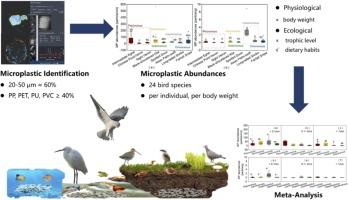Species-specific accumulation of microplastics in different bird species from South China: A comprehensive analysis
IF 12.2
1区 环境科学与生态学
Q1 ENGINEERING, ENVIRONMENTAL
引用次数: 0
Abstract
Microplastics are widespread in many bird species, but the inter-specific variations of microplastic contamination are still unclear. The present study measured microplastics in 24 bird species from South China and investigated the impacts of bird physiological and ecological traits on microplastic contamination. The median abundances of microplastics ranged between 5–167 particles per individual or 0.023–3.58 particles per g body weight. Approximately 60 % of microplastics were within the size range 20–50 µm, with the primary polymer types of polypropylene (PP) and polyethylene terephthalate (PET). There was no significant correlation between microplastic abundances and bird body weights and trophic levels (δ15N) in different bird species. Insectivorous birds had significantly higher abundances of microplastics smaller than 0.1 mm than granivorous, piscivorous, and carnivorous birds (p < 0.01), which was further supported by the meta-analysis of microplastic contamination in birds. On contrary, meta-analysis results indicate that piscivorous birds tend to accumulate larger microplastics (> 1 mm) than other bird species. Microplastic contamination in different bird species was more influenced by diet source rather than trophic level and body weight. Potential ecotoxicological risks were observed for most insectivorous species in the preliminary risk assessment. Particular concern should be paid on insectivorous birds, which have been scarcely studied for microplastics but were at high exposure risks of microplastics among bird species.

华南地区不同鸟类体内微塑料累积的物种特异性:综合分析
微塑料在许多鸟类中广泛存在,但微塑料污染的种间差异仍不清楚。本研究测定了华南地区24种鸟类的微塑料含量,并探讨了鸟类生理生态特征对微塑料污染的影响。微塑料的丰度中位数介于每只个体5-167.2粒或每克体重0.023-3.58粒之间。约 60% 的微塑料大小在 20-50 μm 之间,主要聚合物类型为聚丙烯(PP)和聚对苯二甲酸乙二酯(PET)。不同鸟类的微塑料丰度与鸟类体重和营养级(δ15N)之间没有明显的相关性。食虫鸟类体内小于0.1毫米的微塑料丰度明显高于食谷鸟类、食鱼鸟类和食肉鸟类(p < 0.01),鸟类体内微塑料污染的荟萃分析进一步证实了这一点。相反,荟萃分析结果表明,与其他鸟类相比,食鱼鸟类往往会积聚较大的微塑料(> 1 mm)。不同鸟类的微塑料污染更多受到食物来源而非营养级和体重的影响。在初步风险评估中,大多数食虫鸟类都存在潜在的生态毒理学风险。应特别关注食虫鸟类,这些鸟类对微塑料的研究很少,但在鸟类物种中接触微塑料的风险很高。
本文章由计算机程序翻译,如有差异,请以英文原文为准。
求助全文
约1分钟内获得全文
求助全文
来源期刊

Journal of Hazardous Materials
工程技术-工程:环境
CiteScore
25.40
自引率
5.90%
发文量
3059
审稿时长
58 days
期刊介绍:
The Journal of Hazardous Materials serves as a global platform for promoting cutting-edge research in the field of Environmental Science and Engineering. Our publication features a wide range of articles, including full-length research papers, review articles, and perspectives, with the aim of enhancing our understanding of the dangers and risks associated with various materials concerning public health and the environment. It is important to note that the term "environmental contaminants" refers specifically to substances that pose hazardous effects through contamination, while excluding those that do not have such impacts on the environment or human health. Moreover, we emphasize the distinction between wastes and hazardous materials in order to provide further clarity on the scope of the journal. We have a keen interest in exploring specific compounds and microbial agents that have adverse effects on the environment.
 求助内容:
求助内容: 应助结果提醒方式:
应助结果提醒方式:


